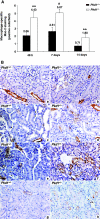Pkd1 haploinsufficiency increases renal damage and induces microcyst formation following ischemia/reperfusion
- PMID: 19833899
- PMCID: PMC2799174
- DOI: 10.1681/ASN.2008040435
Pkd1 haploinsufficiency increases renal damage and induces microcyst formation following ischemia/reperfusion
Erratum in
- J Am Soc Nephrol. 2010 Jun;21(6):1062
Abstract
Mutations in PKD1 cause the majority of cases of autosomal dominant polycystic kidney disease (ADPKD). Because polycystin 1 modulates cell proliferation, cell differentiation, and apoptosis, its lower biologic activity observed in ADPKD might influence the degree of injury after renal ischemia/reperfusion. We induced renal ischemia/reperfusion in 10- to 12-wk-old male noncystic Pkd1(+/-) and wild-type mice. Compared with wild-type mice, heterozygous mice had higher fractional excretions of sodium and potassium and higher serum creatinine after 48 h. In addition, in heterozygous mice, also cortical damage, rates of apoptosis, and inflammatory infiltration into the interstitium at time points out to 14 d after injury all increased, as well as cell proliferation at 48 h and 7 d. The mRNA and protein expression of p21 was lower in heterozygous mice than wild-type mice at 48 h. After 6 wk, we observed dilated tubules, microcysts, and increased renal fibrosis in heterozygotes. The early mortality of heterozygotes was significantly higher than that of wild-type mice when we extended the duration of ischemia from 32 to 35 min. In conclusion, ischemia/reperfusion induces a more severe injury in kidneys of Pkd1-haploinsufficient mice, a process that apparently depends on a relative deficiency of p21 activity, tubular dilation, and microcyst formation. These data suggest the possibility that humans with ADPKD from PKD1 mutations may be at greater risk for damage from renal ischemia/reperfusion injury.
Figures










References
-
- Torres VE, Harris PC, Pirson Y: Autosomal dominant polycystic kidney disease. Lancet 369: 1287–1301, 2007 - PubMed
-
- Gabow PA, Johnson AM, Kaehny WD, Kimberling WJ, Lezotte DC, Duley IT, Jones RH: Factors affecting the progression of renal disease in autosomal-dominant polycystic kidney disease. Kidney Int 41: 1311–1319, 1992 - PubMed
-
- Yoder BK: Role of primary cilia in the pathogenesis of polycystic kidney disease. J Am Soc Nephrol 5: 1381–1388, 2007 - PubMed
-
- Nauli SM, Alenghat FJ, Luo Y, Williams E, Vassilev P, Li X, Elia AE, Lu W, Brown EM, Quinn SJ, Ingber DE, Zhou J: Polycystins 1 and 2 mediate mechanosensation in the primary cilium of kidney cells. Nat Genet 33: 129–137, 2003 - PubMed
-
- Hanaoka K, Qian F, Boletta A, Bhunia AK, Piontek K, Tsiokas L, Sukhatme VP, Guggino WB, Germino GG: Co-assembly of polycystin-1 and -2 produces unique cation-permeable currents. Nature 408: 990–994, 2000 - PubMed
Publication types
MeSH terms
Substances
LinkOut - more resources
Full Text Sources
Other Literature Sources
Medical
Molecular Biology Databases

